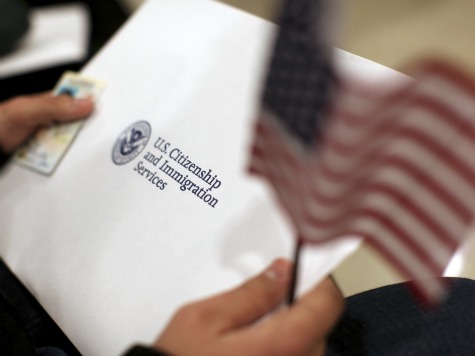
The Heritage Foundation released its long-awaited report detailing the costs of providing a pathway to citizenship to the at least 11 million illegal immigrants in America on Monday. It highlighted the four “phases” such a pathway contains that the conservative think tank argues would drive costs of a such a plan up to $6.3 trillion.
The first phase examined in the report is what current law looks like now. At a press conference Monday, Heritage’s Robert Rector explained that under current law “the average illegal household, because they have restricted access to welfare and so forth, they have a deficit of around $14,000 a year.”
Later in the press conference, Rector estimated that leaving the law as is, without any reform, would cost about $1 trillion.
The second phase of the analysis, which covers the first phase of any potential “amnesty” according to report authors Rector and Jason Richwine the report’s executive summary, would allow illegal immigrants to “be given lawful status but [they] would be denied access to means-tested welfare and Obamacare.” This first phase, what Rector and Richwine alternatively call the “interim” phase, “is likely to last 13 years.”
“Most analysts assume that roughly half of unlawful immigrants work ‘off the books’ and therefore do not pay income or FICA taxes,” Rector and Richwine wrote.
During the interim phase, these “off the books” workers would have a strong incentive to move to “on the books” employment. In addition, their wages would likely go up as they sought jobs in a more open environment. As a result, during the interim period, tax payments would rise and the average fiscal deficit among former unlawful immigrant households would fall.
At the press conference, Rector said, “We predict during that phase, the deficit will actually go down.”
“They will still be in deficit,” Rector added. “They will still be costing the taxpayers about $50 billion a year but the actual annual deficit goes down slightly.”
It is the third phase, the report’s author argue, where all that changes. “However, under the legislation that’s up there on the hill today, in the 13th or 14th year, all of the illegal immigrants or nearly all of them will be given access to 80 different means-tested welfare programs,” Rector said at the press conference. “They also will have been, during the interim period, earning eligibility for Social Security and Medicare. At that point, the costs simply explode.”
The fourth and final phase of the analysis details when illegal immigrants who would have been legalized enter retirement. “Unlawful immigrants are not currently eligible for Social Security and Medicare, but under amnesty they would become so,” Rector and Richwine wrote about that phase. “The cost of this change would be very large indeed.”
Rector noted during the press conference that this fourth phase will likely happen “about 30 to 35 years from now” when those illegal immigrants who receive amnesty reach retirement age. “They will draw down about $22,000 per person, benefits minus any taxes that they’re paying, and the cost is simply astronomical,” he said.

COMMENTS
Please let us know if you're having issues with commenting.